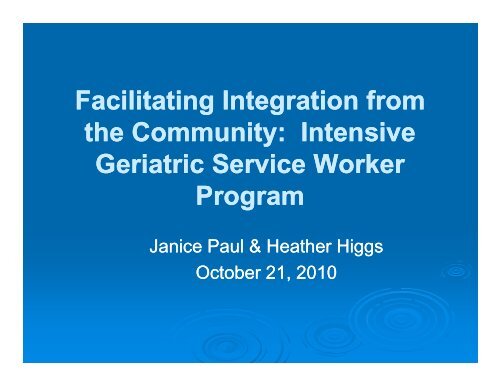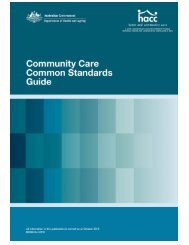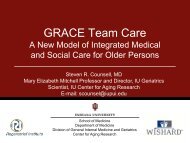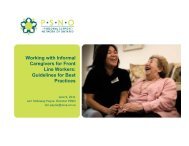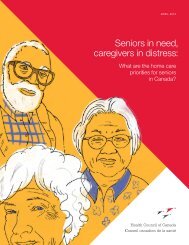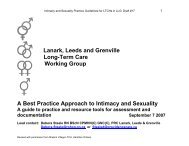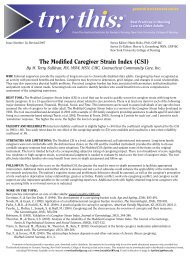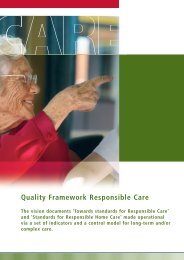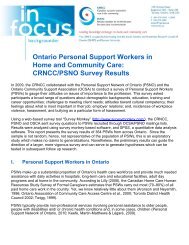Janice Paul and Heather Higgs - crncc
Janice Paul and Heather Higgs - crncc
Janice Paul and Heather Higgs - crncc
- No tags were found...
Create successful ePaper yourself
Turn your PDF publications into a flip-book with our unique Google optimized e-Paper software.
Facilitating Integration fromthe Community: IntensiveGeriatric Service WorkerProgram<strong>Janice</strong> <strong>Paul</strong> & <strong>Heather</strong> <strong>Higgs</strong>October 21, 2010
Overview‣ To describe the integrated service for frail,at-risk seniors in Waterloo Wellington‣ To describe the Intensive Geriatric ServiceWorker program <strong>and</strong> highlight a successstory‣ To review interim evaluation findings <strong>and</strong>highlight lessons learned
What is an integrated system?‣ A cohesive, coordinated model ofdelivering geriatric care‣ Strong partnerships with stakeholders‣ Evidence of improvement in patientoutcome measures‣ Capacity building
What does Integration Mean?‣ Integrated team approach to complexissues‣ Linkages across the continuum of care‣ Targeted to high risk seniors‣ Presently initiated: ED, ALC, SGS—“i “ripple effect”—flows flows across the continuum
How did We Get to Where We are‣ Health Accord Funding‣ RGP Central – Support‣ Networks‣ Partnerships‣ Environmental ScanToday?‣ Linkage with Academic Settings‣ Evaluations‣ Aging at Home Funding
Guiding Principles – High Level‣ Senior Centered: services willrespond to the need of seniors‣ Community Based <strong>and</strong> Integrated:within broader health system‣ Equitable: recognize demographic<strong>and</strong> geographic challenges
Guiding Principles Continued….‣ Cost Effective: best care at optimalcost recognizing benefits ofvolunteerism <strong>and</strong> local communityresponses.‣ Results Oriented: results defined <strong>and</strong>measured
System Accountability‣ WWGSN - System of Care for Seniors –‣ Accountability Agreements signed by allpartners‣ Data collection‣ Ongoing integrated evaluations
Integrated Services for SeniorsDr. John Yang
Design Principles1. Process capable of meeting need <strong>and</strong> dem<strong>and</strong>2. Process will deliver client value <strong>and</strong> demonstrate outcomes3. Robust <strong>and</strong> Reliable4. Uses <strong>and</strong> Improves Existing Infrastructure5. Clearly defined operations that can be enabled with informationtechnology.6. Improves flow by minimizing all types of waste <strong>and</strong> by creating“pull”7. Has positive impact on system goals
Intensive Geriatric Service Worker(IGSW)
Key Roles: IGSWs‣ To implement care plans from GEM Nurses, acute carehealth team (including hospital CCAC Case Manager), orSpecialized Geriatric Services‣ To provide timely intensive support, transition <strong>and</strong> follow-up with primary care, specialty care & communitysupport services‣ To support person-centered self-directed care (i.e.,coach seniors <strong>and</strong> caregivers)
IGSW Goals – Healthy, Happy,Safe
Referral Guidelines‣ Frequent user of the emergency department‣ Recent hospital admission(90 days) <strong>and</strong>/or ED visit (30 days)‣ Complexity of needs(number <strong>and</strong>/or type of support required)‣ Socially isolated
Referral Guidelines (cont’d)‣ Resistant to assistance or support‣ Ability to access services is limited due to financialreasons‣ Language or cultural barrier‣ MD or RN concern about ability to follow through withrecommendations‣ Caregiver burden, lack of caregiver support or long-distance caregiver
ReferralSenior in needProcessEDCommunityHospdatabaseCCACdatabaseHospdatabaseAssessmentGEM <strong>and</strong> CCACAssessmentSGSGeriatric MedicineGeriatric PsychiatryCCACdatabaseTrellisCaseworksDatabaseAdmitHomeProcessbookWebsiteTrellisCaseworksDatabaseIGSWrequiredAssessment& NotesFaxed to IGSWTeamCare plan implemented
Secure Web Portal for GEMreferrals
IGSW appointment slip
IGSW Qualifications‣ Recruitment- IGSWs cross-section section of academic preparation:• Gerontology• Rec therapy• Sociology• Pastoral Care• Psychology• Social Services‣ Geriatric experience within the team:• Community support• Long-term care• Mental Health• Community Ministry• Retirement Home• Day Program• Private Home care• Acute Care• Rehab‣ Language, ethnicity, culture• German, Italian, Dutch, French, Portuguese, Mennonite
CelebratingSuccess
Case ReviewED Presentation:‣ 87 year old female that a neighbour foundw<strong>and</strong>ering in hallway of apartment building.‣ The neighbour noticed an increase in confusion<strong>and</strong> arranged for EMS to take her to the hospital.‣ In the ED she admits she was w<strong>and</strong>ering aroundas she was seeing people in her apartment,including her dead husb<strong>and</strong>. This has beenhappening for quite some time.
Comprehensive GEM AssessmentSocial / Functional:‣ Widow of 4 years, no children. Lives alone in an apartment.‣ Manages bathing / dressing on her own. No trouble toileting.‣ Walks with no aid, but has had several falls “more than I can count”.‣ Reports difficulty managing medications often forgets if she has takenthem or not (this also was evident from her blood work).‣ Meals are a gap, her neighbour assists with groceries but she admits sheis not eating well. She relies on taxis or her neighbour to get around.‣ Is interested in retirement living but does not know how to go about it.Cognition:‣ Admits her memory is poor “My head is all messed up”. MMSE 23/30.‣ She was also having ongoing hallucinations.
PLANAfter the GEM assessment, it was clear that this womenwould benefit from <strong>and</strong> do well with IGSW support. Aplan for discharge was created <strong>and</strong> included:1. Referral to geriatrics (further cognitive assessment<strong>and</strong> falls assessment)2. CCAC to assess3. IGSW to assist arranging meals on wheels,attending appointments, looking at retirementoptions <strong>and</strong> medications compliance.
Bridging gaps …IGSW bridge a huge gap. GEM was able to bookan IGSW appointment prior to ED discharge.‣ Historically, discharge suggestions are made topatients, followed-up by CCAC <strong>and</strong> few suggestionsare followed through by patients. (forget, don’t seeimportance, confused)‣ Discharge suggestions forwarded to IGSW, ‘SmartGoals’ <strong>and</strong> for this patient, every recommendation hasbeen met <strong>and</strong> more
Home in the Community‣ Client seen by IGSW in her home less than 24 hoursafter discharge, joint visit i with CCAC Community CaseManager.‣ During visit, extra medications cleaned out <strong>and</strong>returned to pharmacy. (Entire shopping bag filledincluding medications over 10 years old that shebrought when she moved from Toronto).‣ Client was concerned she missed a pacemakerappointment, called to confirm date of appointment‣ Plans made to accompany client to pacemaker clinicnext week
Smart Goals (as written forclient)The hospital has recommend the following for you.... Book a follow up visit with family doctor Appointment with Geriatrician Visit <strong>and</strong> choose retirement home Ensure correct medications are taken at the correcttime Meals on WheelsI will work with you to arrange the above. I am alsohappy to go with you to these appointments.<strong>Heather</strong> <strong>Higgs</strong>, IGSW519-772-8787x 219
To date‣ Arranged for Meals on Wheels‣ Arranged for medication to be put in ablister pack‣ Accompanied to Pacemaker appointment,drugstore <strong>and</strong> bank‣ Accompanied to Geriatrician‣ Accompanied to Family Doctor
To date (cont’d)‣ Toured 3 different retirement homes‣ Accompanied to the lab for weekly bloodwork‣ Arranged for move to retirement home‣ Follow up visit with Geriatrician‣ Seen in May – moved to retirement homeby end of June.
Currently‣ Using walker‣ Now settled at retirement home <strong>and</strong> is happy with themove. She is aware she was not coping at home.‣ Now eating better (hadn’t cooked since husb<strong>and</strong>passed away several years ago).‣ INR levels regulated‣ Memory is improving‣ Hallucinations have stopped‣ Now socializing regularly – was very isolated before‣ Now safe‣ Family now visiting weekly. At home family wascalling but not visiting.
It Takes a Village‣ Meals on Wheels‣ CCAC services including OccupationalTherapy, PSW <strong>and</strong> nursing‣ Pharmacy Assistant‣ Primary Care doctor‣ Geriatriciani i‣ Friend/Family‣ IGSW
Ongoing involvement:‣ Accompanied to follow up Geriatrician appointment‣ Geriatrician very pleased with her progress <strong>and</strong> wrote inclient’s file: “Since last being seen she has flourished.”‣ Plans to accompany to 2 more appointments‣ Client now confident she can attend appointments onher own or arrange through h family.
Happy, Healthy, Safe“I couldn’t believe it <strong>and</strong> everybody was so nice. Iwish everybody could have the service I had.”
Waterloo WellingtonIntegrated Services forSeniors - Interim EvaluationEvaluatorsCarrie McAiney, PhDLoretta Hillier, M.A.
ReferralsTotal # of clients referred to IGSWs• Guelph site• Waterloo site• Cambridge sitePercentage (#)35142%38%20%Clients served by IGSWs 95% (334)Reasons clients were not served• service was not needed 1.4% (5)• client refused service• client died before first IGSW visit0.3% (1)0.6% (2)• clients waiting to be served2.6% (9)Carrie McAiney &Loretta Hillier 2010
IGSW ActivitiesActivities Percent (#)of HoursClient Contact37%• face-to-face• telephone32%5%Collaterall 19%services/consultation/collaborationDocumentation 19%Administration 13%Travel 12%Carrie McAiney &Loretta Hillier 2010
DischargesNumberTotal # of clients discharged 132 (38%)Among existing clients:• avg. length of time onservice• range89 days1 – 248 daysCarrie McAiney &Loretta Hillier 2010
Referral Sources250208Numbe er of Referr rals20015010050524119 19120GEMInptUnitsSGS Ger'ns CGS AAHNursesCarrie McAiney &Loretta Hillier 2010
Reasons for ReferralActivitiesPercent (#) ofHoursMD / RN concern; Recommendation f/up 58%Social isolation 52%Recent hospital or ED visit 50%Caregiver burden / lack of support 42%Complex needs 40%Resistance to service / support 24%Service access issues due to finances 10%Frequent use of ED 6%Cultural / Language barrier 4%Miscellaneous 1%Carrie McAiney &Loretta Hillier 2010
Client CharacteristicsAge• Mean• RangeGender• Male• Female80 years48 – 95 years36%64%Marital Status• Widowed• Married• Divorced / Separated45%30%12%• Single 9%No family physician 5%Not involved with CCAC 16%Carrie McAiney &Loretta Hillier 2010
IGSW ExperienceGEMIGSWDid not th have to wait itl long to see…• Agree74%83%• Disagree6%0• Neutral 6% 17%Satisfaction with amount of time spent with…• Agree• Disagree• NeutralGreater underst<strong>and</strong>ing of my condition as aresult of interaction with…• Agree• Disagree• Neutral99%01%86%011%97%03%90%010%Carrie McAiney &Loretta Hillier 2010
IGSW: Other ImpactsImpacts as a results of assistance from the IGSWIGSWYour ability to take care of yourself…• Worse now0• About the same13%• Better now 83%Your knowledge of who or what organization to call forservices you need• Worse osenow 0• About the same• Better nowYour ability to meet your goals for better health• Worse now• About the same• Better now27%67%00100%Carrie McAiney &Loretta Hillier 2010
IGSW: Other ImpactsImpacts as a results of assistance from the IGSWIGSWYour health• Worse now0• About the same37%• Better now 57%Your knowledge about when you need to go to the ED• Worse now• About the same• Better nowYour ability to talk to doctors <strong>and</strong> other healthprofessionals about your health• Worse now• About the same• Better now060%37%073%27%Carrie McAiney &Loretta Hillier 2010
Summary of the Ways in Which the IGSWswere Helpful l to Patients/Caregiverst iIncreased access to community support services (16)(e.g., system navigation, Meals on Wheels, home help, personal care, groceryshopping service, Lifeline, friendly visiting, adult day programs, Alzheimer Society)Accompanied client to appointments (14)(e.g., medical appointments, visit housing options, day programs, pharmacy, err<strong>and</strong>s)Emotional support (14)(e.g., someone to talk to at length about concerns, morale support, support tocaregivers – underst<strong>and</strong>ing <strong>and</strong> managing dementia related behaviours)Increased access to information (13)(e.g., information on illness, symptoms, management strategies, housing options,internet access – improved computer skills)Increased access to transportation (10)(e.g., arranged transportation, assisted with application for paratransit/ senior’sservice, or bus pass)Assistance with a variety of tasks (10)(e.g., correspondence client could not underst<strong>and</strong>, preparation of questions fordoctor’s appointment, interpretation of doctor’s recommendations, arranging forincome tax form preparation, management of hoarding behaviours, home safety/ fallprevention, smoking cessation)Carrie McAiney &Loretta Hillier 2010
Summary of the Ways in Which the IGSWswere Helpful l to Patients/Caregivers t i (cont’d)Arranged appointments (5)(e.g., with doctors, dentists, medication review)Follow-up calls <strong>and</strong> visits (3)(e.g., ensures clients are well, questions if they assistance)Communication with family members (3)(e.g., provides clients’ children with updates/ information on health status)Arranged for interventions/ equipment (2)(e.g., physiotherapy, home equipment such as raised toilet seat, grab bars, walkers)Ensured compliance with treatment recommendations (2)(e.g., adherence to medication regime, diet)Identification of issues within the home (1)(e.g., issues that can only be identified by home visit such as safety issues)Carrie McAiney &Loretta Hillier 2010
IGSW: Other ImpactsDo you think the help you received fromthe IGSW has helped to keep you out ofhospital or from visiting the ED?Yes: 53%No: 20%Not sure: 27%Carrie McAiney &Loretta Hillier 2010
Satisfaction with IGSW Service8070Percent of Respons ses605040302010IGSW0Neutral Somewhat Very ExtremelyCarrie McAiney &Loretta Hillier 2010
Selected Quotes“IGSW has gotten me a lot of help. I've had more visitors in thepast 2 months then in the past 2 years. I told the nurse that cameby the other day that my mood is better <strong>and</strong> she asked if I'm everdepressed <strong>and</strong> I said it's been at zero for quite some time now. ““She has helped us with a lot of things <strong>and</strong> this has really madeus feel more confident about being here at home <strong>and</strong> stayinghere a bit longer before we need to move to somewhere whenwe need more assistance. When she says she going to dosomething, she does it, <strong>and</strong> it’s always good to work withsomeone who's dependable. “Carrie McAiney &Loretta Hillier 2010
Evaluation: Next StepsActivityContinue to collect information on referrals &activitiesOngoingWork with LHIN <strong>and</strong> hospitals to obtain moreOngoingdata on ED <strong>and</strong> hospital utilizationTime LineSurveys/Interviews with patients <strong>and</strong> Sept/Oct 2010caregivers Jan/Feb 2011Survey of health professionals January 2011Stakeholder interviews January 2011Carrie McAiney &Loretta Hillier 2010
Lessons Learned: IGSWsFacilitating Factors:‣ Cross-sector sector representation in planning role‣ Formation of: Implementation & OperationalWorking Groups‣ Hiring all 9 IGSWs at the same time‣ IGSWs hosted by a variety of communityorganizations‣ IGSW Lead role‣ Strong partnership CCAC‣ Good IT support‣ Development of SMART goals
Lessons Learned: IGSWs‣ Roles belong to the system not one agency‣ Collaborative approach with GEM Nurses, SGS<strong>and</strong> Acute Care – GEM support does not endwhen senior leaves the hospital‣ IGSWs are part of the Circle of Care‣ Communication
Lessons Learned: IGSWsChallenges:• Differing cultures of the various IGSW host agencies• Role clarity• Lack of uniform information o system (available a ab to all sectors)s)for tracking clients in both community & hospitalService Delivery Issues that t Threaten IGSWEffectiveness:• Keeping up with increasing dem<strong>and</strong>s for service• Maintaining client flow• Managing unrealistic goals from referral sources
Questions
Contact Information‣ <strong>Janice</strong> <strong>Paul</strong> –Intensive Geriatric Service Worker Lead:519-576-2333 x 277, cell 519-400400-8176,jpaul@trellis.on.ca‣ <strong>Heather</strong> <strong>Higgs</strong> – Intensive Geriatric Service Workerhhiggs@trellis.on.ca‣ Jane McKinnon Wilson –Waterloo Wellington Geriatric SystemsCoordinator: jmckinnon@trellis.on.caca‣ Maria Boyes- GEM Clinical Resource Consultant:mboyes@cmh.org‣ Carrie McAiney – Lead Evaluator: mcaineyc@mcmaster.ca


